⚡️ Today’s level up ⚡️
In this edition (part 3 of a 4-part series), I’ll summarize and deconstruct the next 2 books in my essentials library that heavily influenced my 7 figure earning personal operating system. If you missed the first 4, be sure to catch up here and here.
The mission:
→ Read this in <7 minutes right now
→ Understand 16 key concepts from 2 essential reads
→ Elevate your own personal operating system using them
→ Join The Make More Hustle Less Club to build & share together
Let’s go…
The Next 16 Key Concepts That Elevated How I Operated
Over the past 2 years, I have read the 8 best books for developing an effective personal operating system — twice.
I have distilled them down to the 50 key insights that will upgrade your life.
Save yourself time and just implement these life-changing concepts.
In part 1, I defined what a personal operating system is and introduced the first 16 concepts. Last week, I covered concepts 16 – 24. This week, I share concepts 25 – 41.
Book #4: Indistractable by Nir Eyal
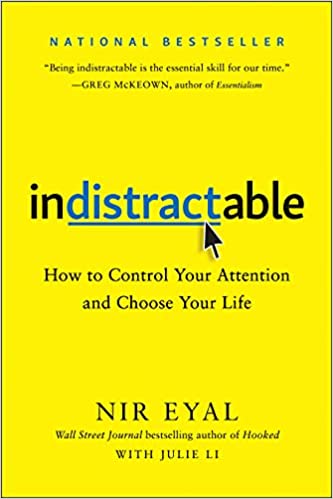
In this day and age, if you are not equipped to manage distractions, your brain will be manipulated by time-wasting diversions.
The antidote to impulsiveness is forethought. Planning ahead ensures you will follow through. In this book, you’ll learn exactly what to do to control your attention and choose your life.
What does it mean to be indistractable?
All behaviors, whether they tend toward traction or distraction, are prompted by triggers, internal or external. Whether prompted by internal or external triggers, the resulting action is either aligned with our broader intention (traction) or misaligned (distraction).
Traction helps us accomplish goals; distraction leads us away from them.

Key Concept (25): Stop Getting Distracted By Internal Triggers
The root cause of all of our behaviors is the desire to relieve discomfort.
Distraction is an unhealthy escape from reality. If we want to master distraction, we must learn to deal with discomfort. This can be done in 4 steps:
- Look for the emotion that precedes every distraction. Try to figure out your internal trigger.
- Write it down. Include details like the time of day, what were you doing and how you felt then.
- Explore the negative sensation with curiosity instead of contempt (observation).
- Be extra aware of liminal moments: Transitions that move us from one thing to another throughout our day.
Key Concept (26): Make Time For The Things You Really Want To Do
“If I know how you spend your time, I know what might become of you.”
We should guard one of our most precious assets: our time. If we don’t plan our days, someone else will. Instead of starting with what are we going to do, we should begin with why we’re going to do it.
Our values are like a compass for navigating all our life choices.
We should set aside a specific time in our schedules for traction: the actions that move us toward what we want in life. You can’t call something a distraction unless you know what it’s distracting you from.
The most effective way to make time for traction is through timeboxing: Deciding what you’re going to do, and when you’re going to do it.
The goal here is to eliminate all white space on your calendar, so you’re left with a template for how you intend to spend your time each day.
P.S. I have worked with many tools over my professional career, and the best tool for timeboxing that I use each day is Sunsama. Try it for free HERE
Every week, book 15 minutes of your schedule to refine your calendar by asking two questions:
- When in my schedule did I do what I said I would do, and when did I get distracted? If you got distracted, find strategies to cope with it next time.
- Are there any changes I need to make to give me the time I need to live out my values?
Focus on inputs — not outcomes. When it comes to time, we should stop worrying about outcomes we can’t control and instead focus on the inputs we can control. You can’t know if the breakthrough idea will come to you when you sit down at your desk.
But one thing is certain: Not showing up guarantees failure. Your goal is to show up every time.
Areas to schedule (the book goes into more detail on specific tactics):
→ Schedule time for you
→ Schedule time for important relationships
Key Concept (27): Stop Getting Distracted by External Triggers
Cues in our environment like rings from devices and interruptions from other people frequently take us off track.
That’s why we should defend our focus.
Areas to hack back (the book goes into more detail on specific tactics):
→ Hack back email
→ Hack back feeds
→ Hack back meetings
→ Hack back group chat
→ Hack back your desktop
→ Hack back online articles
→ Hack back your smartphone
→ Hack back work interruptions
Key Concept (28): Use Precommitments To Prevent Distractions
A precommitment is removing a future choice in order to overcome impulsivity.
Many successful people aren’t less impulsive; they just take drastic steps to keep themselves focused.
- Effort pacts: An effort pact prevents distraction by making unwanted behaviors more difficult to do.
- Price pacts: A price pact involves putting money on the line to encourage us to do what we say we will.
- Identity pacts: You tend to align your actions with how you see yourself.
Keep a timeboxed schedule and share it with others.
Book #6: Getting Things Done by David Allen
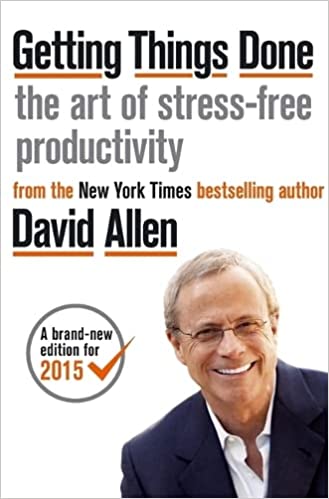
“Your mind is for having ideas, not holding them.” (author, David Allen)
This book is a manual for stress-free productivity. GTD helps you set up a trusted system of lists, reminders, and weekly reviews, in order to free your mind from having to remember tasks and to-dos and instead let it work at full focus on the task at hand.
Key Concept (29): The Right Framework Can Help You Maintain Focus
We struggle to focus our attention on the right tasks, and often can’t keep track of the wide range of things we want or need to do.
This lack of strategy means we don’t prioritize efficiently, and it can make us feel overwhelmed. Allen’s methodology will help you navigate projects, daily to-dos, and anything else you need to get done, without getting stressed.

Key Concept (30): Create An Inbox (”In-List”) of Everything You Need To Get Done
When you’re forced to track open loops in multiple locations, it makes it much harder to move any of them forward.
The first step of GTD is to Capture every single one of your open loops into an in-list. Your in-list can be a document, folder, or app (you can have one for physical and digital items). For now, just write down everything you need to do and don’t bother thinking about how to do it.
Your only goal is to get everything into one, unified list.
Now whenever a new open loop crops up, you can store it here instead of worrying about how to get it done in the moment.
Then once it’s in your in-list, you can return to it when you have time, consider what needs to get done, and organize accordingly.
Key Concept (31): Decide If An Open Loop Is Actionable Or Not
Typical actionable items are “respond to email” or “prep for upcoming meeting.”
Nonactionable items are those that don’t require a specific action at this time. Nonactionable items include: trash (things you don’t need), items you don’t need now, but will later, as well as items with useful information you need to reference.
Once you’ve determined which items are actionable or not, you can prioritize your actionable items to start getting them done.
And you can organize your nonactionable items for later.

Key Concept (32): Clarify: Actionable Items Require A Physical And Visible Next Action
To feel less stressed out about tasks we need to get done, we need to change how we write them down.
Take for example a vague actionable item like “set up doctor’s appointment.” How can we clarify what needs to get done in order to move this item forward? The physical and visible next action might be “Call Dr. Jungst and set up appointment for next Tuesday,” for example.
Key Concept (33): If An Actionable Items Takes Less Than 2 Minutes To Do, Just Do It Now
That’s because planning when to complete a two-minute task will take longer than just doing it. You’ll get it off your plate, and keep your number of open loops down.
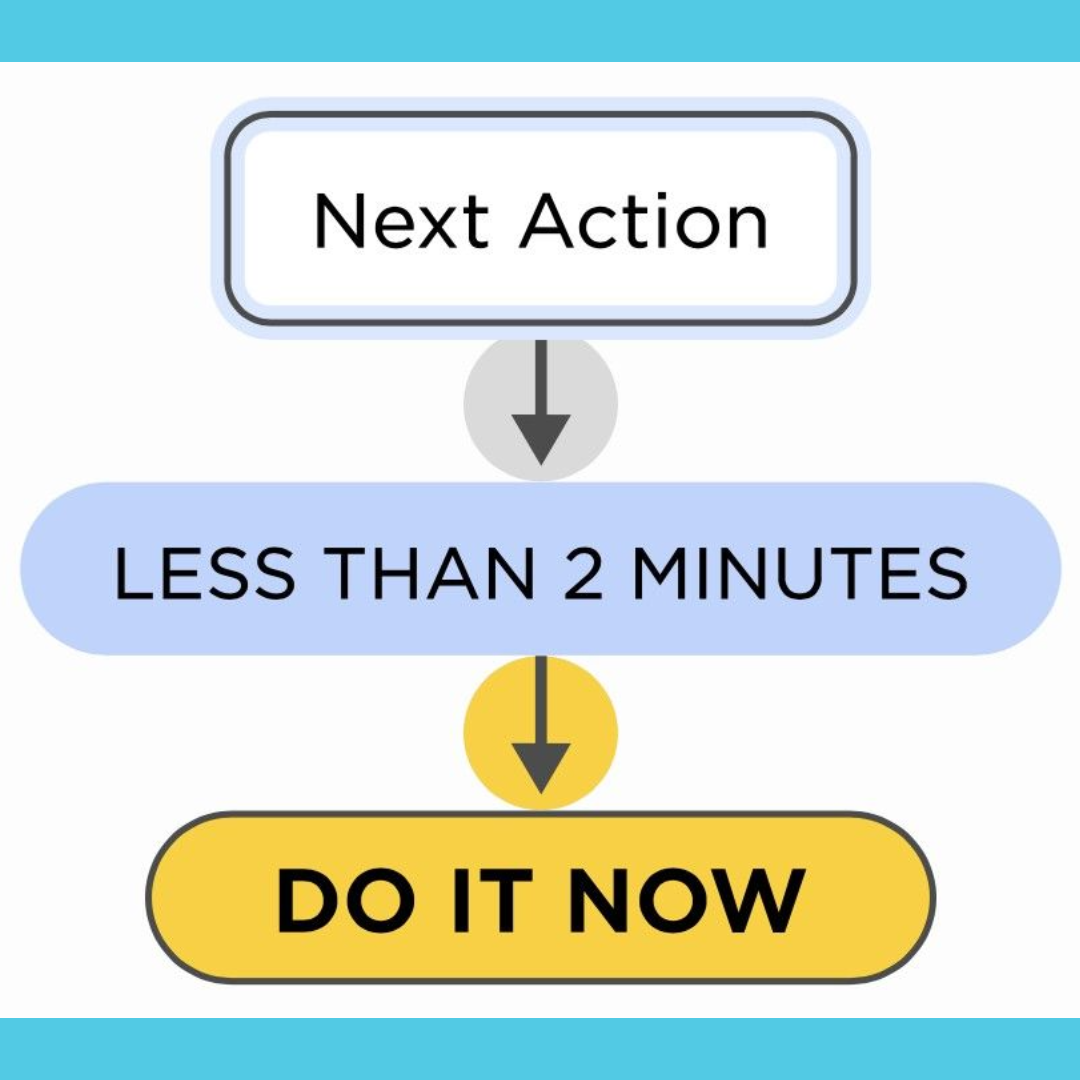
Once your next actions are defined, you can add them to a Next Actions list, your Calendar, or delegate them.
Key Concept (34): Organize: Use a Next Actions List To Track Your Daily Reminders
Some of the next actions you’ve determined will need to happen as soon as possible.
Add these to a Next Actions list. Instead of listing something like “progress the United account” on your Next Actions list, write “read United’s earnings transcript and develop 3 new insights for personalized point of view” for example. Being specific about your next action will ensure that when you review your Next Actions list, you’ll know exactly what to do.
In an effort to make your Next Actions list more manageable, you can also split it up into different contexts.
“Computer” (i.e. for research) Next Actions, or “Phone” (i.e. for calls) Next Actions are two examples.
Remember, these are the things you need to get done as soon as possible, so you should review this list daily.
Key Concept (35): Organize: Use A “Waiting For” List To Track Tasks You’ve Delegated To Others
After you’ve delegated these tasks, you can keep track of them by adding items to a ‘Waiting For’ list.
This list will allow you to monitor these open loops without having them distract from what you, and only you, actually need to do.
Monitor this list once a week to ensure these tasks are moving forward as they should.
Key Concept (36): Organize: Only Use Your Calendar For Date-Specific Tasks
If you see an actionable item that needs to happen on a specific date, you can add this to your Calendar.
But you shouldn’t put a reminder on a specific day unless it really needs to be done that day.
For example, if you know Tuesday afternoons are the only day you can meet with a colleague, you can add that.
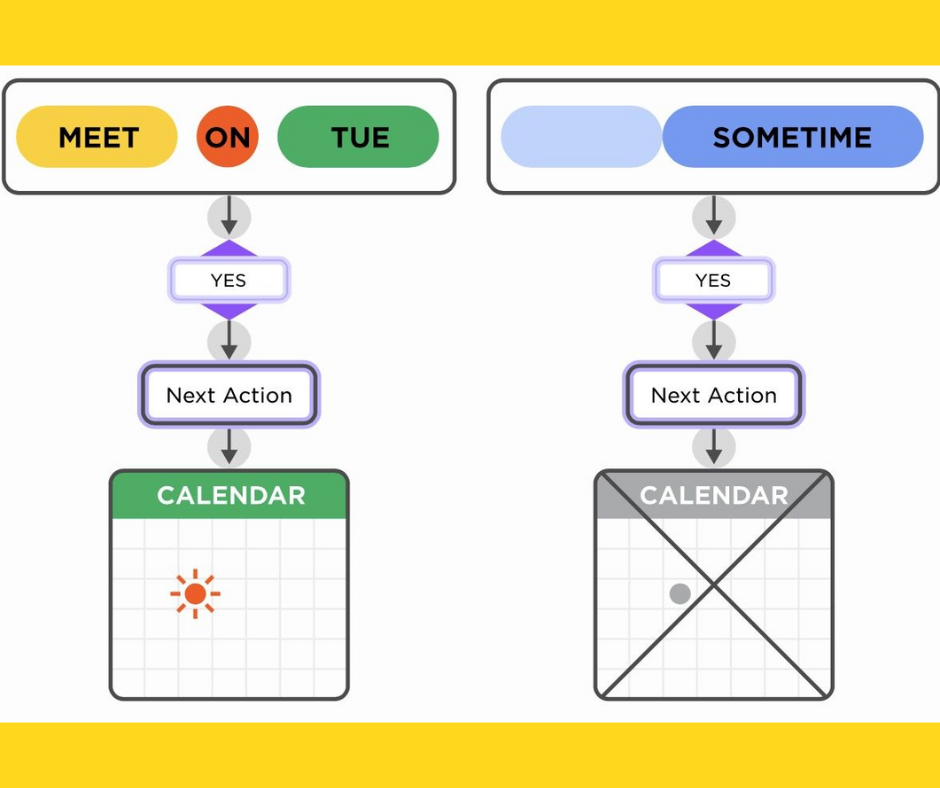
But don’t remind yourself to “work on your personal brand,” for example, unless it can only happen on a specific day.
That way when you see a reminder on your Calendar, you really know it needs to get done then.
And you won’t keep pushing it off until suddenly you’ve missed a deadline.
Key Concept (37): Move Projects Forward By Focusing Only On The Immediate Next Action
To make even the most daunting projects manageable, you should focus only on the immediate next action required to move it forward.
What’s the immediate next action required to move this project forward? You should add this next action to your Next Actions list. Once you complete it, you can determine another immediate next action.
Then, every time you check your Next Actions list you can move your project forward, little by little.
Key Concept (38): Make Your In-List As Clutter-Free As Possible
Your goal is to always have an in-list as operational as possible, which means no clutter.
Otherwise, you’ll be less likely to use it.
This means you shouldn’t let open loops, even those you don’t need to deal with right now, stay in your in-list interminably.
Instead, you can organize them into lists to review on a weekly basis.
These open loops might include future projects or things you’ll need to access during a specific time.

Key Concept (39): Keep a Someday/Maybe List For Potential Future Projects
To keep track of potential projects or ideas, add them to a Someday/Maybe list.
Allen calls this your “parking lot” for projects you don’t want to tackle right now. This list can be a place where you draw inspiration from when you’re ready for something new. In order to get the most out of your Someday/Maybe list, review it weekly so you can move forward with a project when you have time.
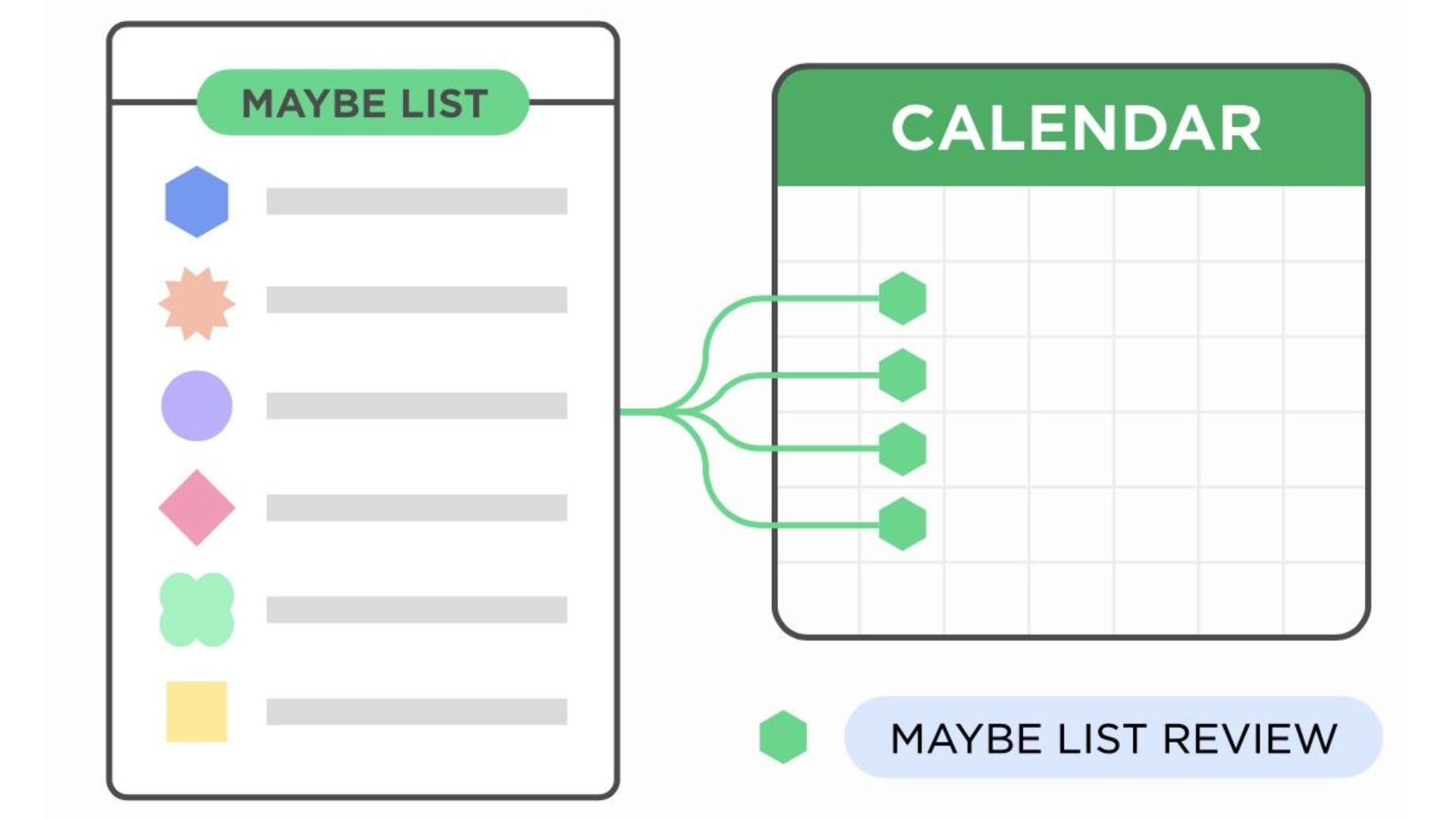
As you continue to use GTD, you can add any inspirational ideas or projects to this list and refer to it in the future.
Key Concept (40): Use A Tickler File To Save Items For A Specific Time Period
For nonactionable items you’ll eventually need to do something about, you can use a Tickler File.
A Tickler File is a way to “tickle” your memory in the future. This is where you can put things you need to access during a specific time. To set up your Tickler File, Allen recommends having one file for every month. For example, if you have a conference in October, you can add the documents you’ll need then to your October file in your Tickler File.
This doesn’t need to be just for work — you can add in birthdays, holidays, and other things you plan to deal with on a particular day or month.
Key Concept (41): Collect Open Loops And Review Your Lists Once A Week
Every day, you should reference your Next Actions list and Calendar.
But to make sure all your lists are helping you accomplish what you need them to, you also need to conduct a Weekly Review. To do this, pick a specific day once a week where you’ll follow the GTD methodology from top to bottom. This means gathering all your open loops into an in-list and going through one by one.
After, you’ll review all your ongoing lists to make sure they’re as complete and up-to-date as possible.
Doing a Weekly Review will ensure that when you need to work off your lists, there won’t be loose ends you’re not sure what to do with. You’ll be able to trust that your lists are accurately portraying what requires your immediate focus. And this will give you the confidence to handle the constant wave of new tasks without feeling stressed.
Here’s a complete visual of the GTD system:

That’s a wrap. See you next week when I reveal the final 2 books and 10 key concepts!
🐝
When you’re ready, here are 3 ways I can help you:
1. Get the exact system I’ve used to go from earning $200K to over $1M a year in SaaS sales without burning out here. (3,000+ students)
2. Join a community of Purpose-Curious™ sellers in the Make More Hustle Less Club where we develop a personal operating system together here. (300+ members)
3. Book a 1:1 coaching session to up-level your performance here. (Limited spots available)


